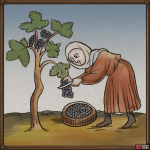Text
In Bohemia, viticulture began spreading from the 10th century onwards, primarily for liturgical purposes. Between the 11th and 13th centuries, vineyards were established mainly by monasteries and the nobility in locations similar to those where grapes are grown today, especially in southern Moravia. While the favorable climate initially allowed grape cultivation even in Bohemia, a later period of global cooling caused the vines to die off.
Caring for grapevines occupied winemakers throughout the year, with the harvest traditionally taking place from October to November, depending on the weather. Grapes were typically cultivated in areas unsuitable for other crops, such as rocky southern slopes. Establishing a new vineyard could take three to four years, with optimal productivity lasting around thirty to forty years
The harvested grapes were collected and then poured into vats, where they were crushed by foot. White grapes were immediately pressed and stored in wooden, pitch-sealed, and sulfurised barrels where fermentation took place. Red grapes were crushed, destemmed, and left to ferment in open vats with regular stirring. This produced a substance known as “must,” which was pressed after a few days, and the entire mixture was then transferred to barrels.
A great lover of wine was King ![]() Charles IV, who imported cultivation methods and certain grape varieties from France and granted numerous privileges to winemakers.
Charles IV, who imported cultivation methods and certain grape varieties from France and granted numerous privileges to winemakers.


No Comments